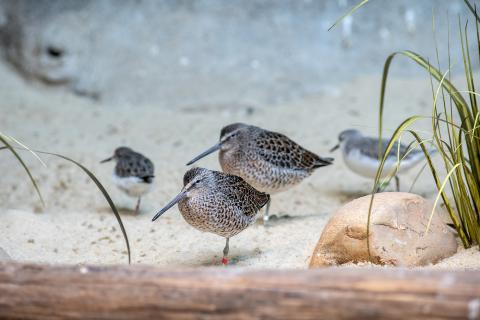Physical Description
A hermit crab's front half is covered with a hard exoskeleton, like that of most other crabs. Its long abdomen has a softer exoskeleton, which can adapt to fit into a spiraled snail shell. A hermit crab presses its abdomen, its fourth and fifth pairs of legs, and the appendages at the end of its abdomen (called uropods) against the shell's inner wall by contracting its longitudinal muscles.
Its large, left uropod hooks to the center post of the shell. It is used for defense, holding onto tree limbs and balance. The smaller, right claw and the next pair of appendages, which also have claws, are used for collecting and passing food and water to the crab's mouth. Rough surfaces help hold the crab in the shell.
Hermit crabs have reduced gills, and their moist gill chambers have highly vascularized areas for gas exchange. They have stalked eyes with acute vision, and two pairs of antennae. They use the longer pair for feeling and the shorter, feathery pair for smelling and tasting. They also have sensory hairs that are part of the exoskeleton. They use these hairs and their antennae as vibration sensors.
Hermit crabs molt as they grow, shedding their exoskeletons and creating new, larger ones to accommodate their larger bodies. A crab molts by building up enough water pressure in its body to split its old shell. Some crabs leave their shell and bury themselves in sand to molt. Some species store water in their shell before molting and remain in the shell throughout the molt, which may take from 45 to 120 days.
You can tell that a crab is freshly molted when it has a clean, bluish color. A crab may eat its molted shell, possibly for its calcium, vitamins and minerals.
When selecting a new shell, a hermit crab follows a series of steps:
- Explore the shell visually
- Test the shell for movability
- Explore the shell's surface texture
- Explore the external shape of the shell
- Test the shell's opening (Is it clear? Can the hermit crab get in?)
- Check the internal size to see if it can make a snap withdrawal
- Turn the shell upside down to make sure it can right itself again
Size
Hermit crab species come in a range of sizes, from a fraction of an inch (a few millimeters) to nearly the size of a coconut.
Native Habitat
Many different species of land hermit crabs live in tropical areas of the Indo-Pacific region, the western Atlantic and the western Caribbean.
Land hermit crabs live close to the shoreline and must have access to both land and water. They use pools and crevices of sea water to wet their gills and the interiors of their shells, and they reproduce and spend their early stages in water. Other hermit crab species are entirely aquatic.
Food/Eating Habits
Hermit crabs are omnivorous scavengers. They eat whatever they find, although not the former occupants of the shells they use.
At the Smithsonian's National Zoo, land hermit crabs are fed crab food and assorted fruits and vegetables.
Reproduction and Development
Hermit crabs mate in seawater. Before mating, the male holds the female with one claw, and then taps or strokes her with the other or pulls her back and forth. Both crabs emerge partially from their shells, placing their stomachs together to mate.
After the eggs hatch, the larvae go through several aquatic life stages and molts. When adulthood is reached, the crabs migrate to shore for a terrestrial life.
Conservation Efforts
Hermit crabs are extremely popular pets and are readily available in pet stores, particularly those with nearby access to the ocean. However, the hermit crab pet business is unsustainable. Hermit crabs do not breed in human care; they return to the ocean to breed and live out the first part of their lives. As a result, all hermit crabs purchased through pet shops come from the wild.
Land hermit crabs are also at risk of habitat loss, as the mangroves and coastal areas where they live are taken over and developed by humans.
Help this Species
- Choose your pets wisely, and do your research before bringing an animal home. Exotic animals don’t always make great pets. Many require special care and live for a long time. Tropical reptiles and small mammals are often traded internationally and may be victims of the illegal pet trade. Never release animals that have been kept as pets into the wild.
- Avoid single-use plastics, such as plastic bottles, bags and utensils. Choosing reusable options instead can help reduce plastic pollution.
- Protect local waterways by using fewer pesticides when caring for your garden or lawn. Using fertilizers sparingly, keeping storm drains free of litter and picking up after your pet can also improve watershed health.
- Save water by switching to low-energy appliances, fixing leaks and turning off faucets when they aren't in use.
Animal News

Leaf-tailed Gecko Treated for Skin Cancer With Chemotherapy




